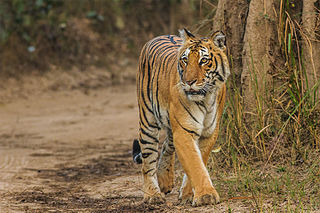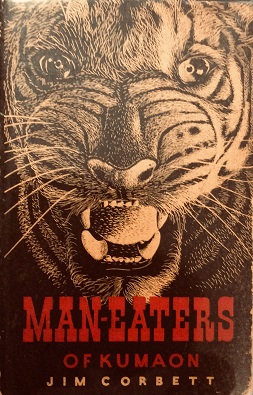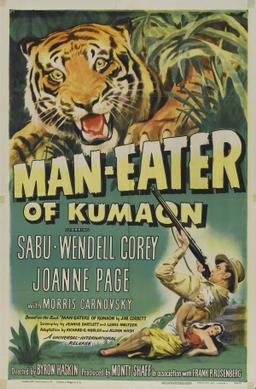
The Bengal tiger is a population of the Panthera tigris tigris subspecies and the nominate tiger subspecies. It ranks among the biggest wild cats alive today. It is considered to belong to the world's charismatic megafauna.

Jim Corbett National Park is a national park in India located in the Nainital district of Uttarakhand state. The first national park in India, it was established in 1936 during the British Raj and named Hailey National Park after William Malcolm Hailey, a governor of the United Provinces in which it was then located. In 1956, nearly a decade after India's independence, it was renamed Corbett National Park after the hunter and naturalist Jim Corbett, who had played a leading role in its establishment and had died the year before. The park was the first to come under the Project Tiger initiative.

Kenneth Douglas Stewart Anderson was an Indian writer and hunter who wrote books about his adventures in the jungles of South India.

Edward James Corbett was an Anglo-Indian hunter, tracker, naturalist and author. He was frequently called upon by the Government of the United Provinces of Agra and Oudh to kill man-eating tigers and leopards that were attacking people in the nearby villages of the Kumaon and Garhwal Divisions. He recounted his hunts and experiences in books like Man-Eaters of Kumaon, which enjoyed critical acclaim and commercial success. He was also an avid photographer and spoke out for the need to protect India's wildlife from extermination.

Man-Eaters of Kumaon is a 1944 book written by hunter-naturalist Jim Corbett. It details the experiences that Corbett had in the Kumaon region of India from the 1900s to the 1930s, while hunting man-eating Bengal tigers and Indian leopards. One tiger, for example, was responsible for over 400 human deaths. Man-Eaters of Kumaon is the best known of Corbett's books, and contains 10 stories of tracking and shooting man-eaters in the Indian Himalayas during the early years of the twentieth century. The text also contains incidental information on flora, fauna and village life. Seven of the stories were first published privately as Jungle Stories.

Mukteshwar is a village and tourist destination in the Nainital district of Uttarakhand, India. It sits high in the Kumaon Hills at an altitude of 2171 meters (7500 feet), 51 km from Nainital, 72 km from Haldwani, and 343 km from Delhi.

The Leopard of Rudraprayag was a male man-eating leopard, reputed to have killed over 125 people. It was eventually killed by hunter and author Jim Corbett.

The Indian leopard is a subspecies of the leopard that was first scientifically described in 1794. It is widely distributed on the Indian subcontinent. It is threatened by illegal trade of skins and body parts, and persecution due to human-leopard conflict and retaliation for livestock depredation.
Manhunters was a three-part TV drama series that aired on BBC Two in the United Kingdom in 2005. It tells the story of three cases of man-eaters through the memoirs of those who hunted them and, in the case of the third episode, accidentally unleashed them on their community. The first tells the story of Jim Corbett, played by Jason Flemyng and the Man-Eating Leopard of Rudraprayag. The second tells the story of George Rushby and the Lions of Njombe, and the third tells the story of the Wolf of Gysinge.
A man-eater is an individual animal or being that preys on humans as a pattern of hunting behavior. This does not include the scavenging of corpses, a single attack born of opportunity or desperate hunger, or the incidental eating of a human that the animal has killed in self-defense. However, all three cases may habituate an animal to eating human flesh or to attacking humans, and may foster the development of man-eating behavior.

Tiger attacks are a form of human–wildlife conflict which have killed more humans than attacks by any of the other big cats, with the majority of these attacks occurring in Bangladesh, India, Nepal and Southeast Asia.

The .500 Black Powder Express was a series of Black powder cases of varying lengths that emerged in the 1860s.
Raymond Sheppard was a British artist and illustrator of books for children and adults. He wrote books on drawing techniques, but is best known for his illustrations of Ernest Hemingway's 1952 novel The Old Man and the Sea and the works of Jim Corbett.
Smriti Mishra is an Indian actress, most known for her roles in Shyam Benegal's Sardari Begum (1996), Sudhir Mishra's Is Raat Ki Subah Nahin (1996), Pamela Rooks's Train to Pakistan (1998), Manish Tiwary's Dil Dosti Etc (2007) and Vijay Singh's Jaya Ganga (1996).

Man-Eater of Kumaon is a 1948 American adventure film directed by Byron Haskin and starring Sabu, Wendell Corey and Joanne Page. The film was made after the success of the Jim Corbett book Man-Eaters of Kumaon, published by Oxford University Press in 1944.

Gurney House is a historic building located in Nainital, Uttarakhand, India, and was the residence of hunter-conservationist and writer Jim Corbett till he left India in 1947. Currently it is a private residence.
Kal: Yesterday and Tomorrow is a 2005 Indian Hindi-language thriller drama film written and directed by Ruchi Narain. Produced by Sudhir Mishra under Sudhir Mishra Productions, the film features an ensemble cast of Chitrangda Singh, Shiney Ahuja, Smriti Mishra, Ram Kapoor, Malaika Shenoy, Sarika and Boman Irani. Shantanu Moitra composed the soundtrack and Sneha Khanwalkar composed the title track and the background score. While Prakash Kutty and Ranjeet Bahadur handled cinematography and editing respectively. The film was premiered at 7th Osian's Cinefan Festival of Asian and Arab Cinema in July 2005 won Indian Critics’ Award and released on 16 September 2005.
The Chuka man-eating tiger was a male Bengal tiger responsible for the death of three boys from Thak village in the Ladhya Valley in 1937. It was shot by Jim Corbett in April 1937 who noted that the animal had a broken canine tooth and several gunshot wounds in various parts of his body.

The Bachelor of Powalgarh also known as the King of Powalgarh, was an unusually large male Bengal tiger, said to have been 10 feet 7 inches long. From 1920 to 1930, the Bachelor was the most sought-after big-game trophy in the United Provinces. British hunter Jim Corbett shot and killed the Bachelor in the winter of 1930, and later told the story in his 1944 book Man-Eaters of Kumaon.

Leopard attacks are attacks inflicted upon humans, other leopards and other animals by the leopard. The frequency of leopard attacks on humans varies by geographical region and historical period. Despite the leopard's extensive range from sub-Saharan Africa to Southeast Asia, attacks are regularly reported only in India and Nepal. Among the five "big cats", leopards are less likely to become man-eaters—only jaguars and snow leopards have a less fearsome reputation. However, leopards are established predators of non-human primates, sometimes preying on species as large as the western lowland gorilla. Other primates may make up 80% of the leopard's diet. While leopards generally avoid humans, they tolerate proximity to humans better than lions and tigers, and often come into conflict with humans when raiding livestock.













